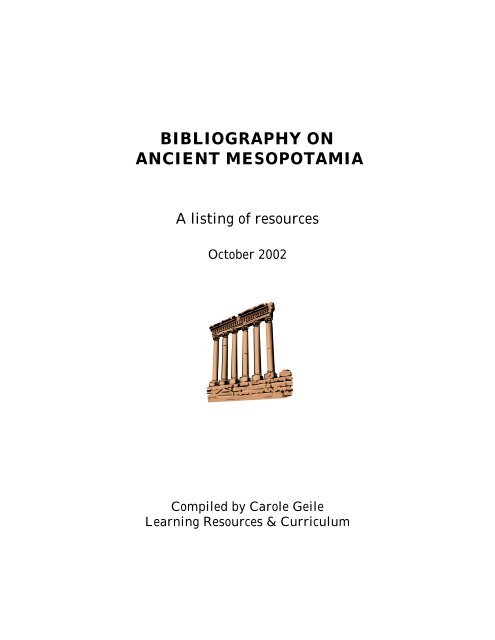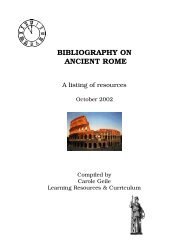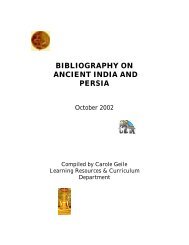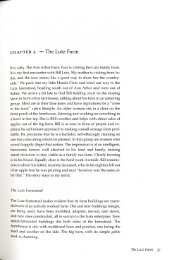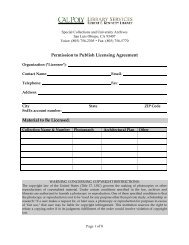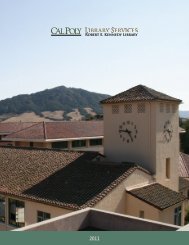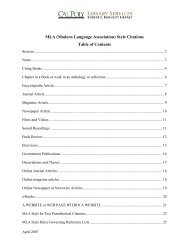Bibliography on ancient mesopotamia
Bibliography on ancient mesopotamia
Bibliography on ancient mesopotamia
Create successful ePaper yourself
Turn your PDF publications into a flip-book with our unique Google optimized e-Paper software.
BIBLIOGRAPHY ON<br />
ANCIENT MESOPOTAMIA<br />
A listing of resources<br />
October 2002<br />
Compiled by Carole Geile<br />
Learning Resources & Curriculum
ANCIENT MESOPOTAMIA<br />
BIBLIOGRAPHY<br />
BOOK RESOURCES<br />
Baumann, Hans. In the land of Ur: the discovery of <strong>ancient</strong> Mesopotamia. New<br />
York: Panthe<strong>on</strong> Books, 1969. (WB 935 BAU32)<br />
Summary: Describes archaeological finds in Mesopotamia and what they have<br />
revealed of the <strong>ancient</strong> civilizati<strong>on</strong>s of that area.<br />
Currier, Richard L. City planning in <strong>ancient</strong> times. Minneapolis, MI: Lerner<br />
Publicati<strong>on</strong>s Company, 1977. (WB 913 CUR93C)<br />
Summary: Examines the art of city planning as it was in <strong>ancient</strong> times, and<br />
describes some of the oldest planned cities, now in ruins, of Greece, the<br />
Roman Empire, Egypt, and Mesopotamia. Grade 5 and up.<br />
Everyday life in <strong>ancient</strong> times: highlights of the beginnings of Western civilizati<strong>on</strong> in<br />
Mesopotamia, Egypt, Greece, and Rome. Washingt<strong>on</strong>, DC: Nati<strong>on</strong>al Geographic<br />
Society, 1961. (OVR WB 930 NAT21E)<br />
Summary: These four <strong>ancient</strong> countries put in more time <strong>on</strong> the progress of<br />
mankind than did any other country or people. Mesopotamia gave us<br />
writing, metallurgy, law, and such basic inventi<strong>on</strong>s as the wheel and the<br />
true arch. From it also came the razor, the frying pan, and the 60minute<br />
hour.<br />
Lauber, Patricia. The story of numbers. New York: Random House, 1961. (WB 510<br />
LAU36)<br />
Summary: Tells of early man's first need to count, the influence of agriculture and<br />
herding <strong>on</strong> the development of the tally, and numerical systems from<br />
Egypt, Mesopotamia, China, Rome, and India.<br />
Maestro, Betsy. The discovery of the Americas. New York: Lothrop, Lee & Shepard<br />
Books, 1990. (OVR WB 973.1 MAE268D)<br />
Summary: Discusses both hypothetical and historical voyages of discovery to<br />
America by the Phoenicians, Saint Brendan of Ireland, the Vikings, and<br />
2
such later European navigators as Columbus, Cabot and Magellan.<br />
Grade 1 and up.<br />
Millard, Anne. The atlas of <strong>ancient</strong> worlds. New York: Dorling Kindersley, 1994.<br />
(OVR WB 911 MIL611A)<br />
Summary: Explores the history of the <strong>ancient</strong> world from the Sumerians in 3500<br />
B.C. to the Incas in 1500 A.D. Includes Phoenicians: rulers of the sea.<br />
Grades 5 and up.<br />
Mollet, David. Ancient civilizati<strong>on</strong>s: Israelites. Torrance, CA: Waldorf Educati<strong>on</strong><br />
Resources, 1994. (WT 300 6ZMOLAN22C48)<br />
Summary: Ancient Israelites comes alive for 6 th graders to explore such topics as<br />
their historical and geographical background, judges, kings, prophets,<br />
and their Persian, Greek, and Roman rule.<br />
Mollet, David. Ancient civilizati<strong>on</strong>s: Mesopotamia. Torrance, CA: Waldorf<br />
Educati<strong>on</strong> Resources, 1993. (WT 300 6ZMOL AN22C6)<br />
Ancient Mesopotamia comes alive for 6 th graders to explore such topics<br />
as their historical and geographical background, mythology and<br />
religi<strong>on</strong>, from Sarg<strong>on</strong> to Hammurabi, and Babyl<strong>on</strong>ia and Assyria.<br />
Moss, Carol. Science in Ancient Mesopotamia. New York: Franklin Watts, 1988.<br />
(WB 509.35 MOS855S)<br />
Summary: Describes the enormous accomplishments of the Sumerians and<br />
Babyl<strong>on</strong>ians of Ancient Mesopotamia in every scientific area, a heritage<br />
which affects our own everyday lives. Grades 5-9.<br />
Nardo, D<strong>on</strong>. The Assyrian Empire. San Diego, CA: Lucent Books, 1998. (WB<br />
935.03 NAR166A)<br />
Summary: Discusses the history of the Assyrian Empire, including its early people,<br />
the rise of the Assyrian nati<strong>on</strong>, its rebirth, the empire at its height, and<br />
the nati<strong>on</strong>'s collapse. Includes a secti<strong>on</strong> <strong>on</strong> between the great rivers: the<br />
early peoples of Mesopotamia. Grades 5-9.<br />
Near East <strong>ancient</strong> civilizati<strong>on</strong>s - Egypt, Mesopotamia, Babyl<strong>on</strong>ia, Sumeria. Oroville,<br />
CA: Butte County Office of Educati<strong>on</strong> Curriculum Resource Center, 1992. (WU 300<br />
S/BUTT.C N27E)<br />
3
Summary: Middle school and high school levels.<br />
Neurath, Marie. They lived like this in <strong>ancient</strong> Mesopotamia. New York: Franklin<br />
Watts, 1964. (WB 935 NEU39T)<br />
Summary: A short story <strong>on</strong> what life was like in this <strong>ancient</strong> city.<br />
Odijk, Pamela. The Israelites. Englewood Cliffs, NJ: Silver Burdett Press, 1990.<br />
(OVR WB 933 ODI35I)<br />
Summary: Explores Jewish life and culture in <strong>ancient</strong> Israel. Grades 5-8.<br />
Pofahl, Jane. Ancient civilizati<strong>on</strong>s: Mesopotamia. Minneapolis, MI: T.S. Denis<strong>on</strong> &<br />
Company, 1993. (WE 300 DENI P752A6)<br />
Summary: The Time Traveler Series will aid you as you teach the colorful history<br />
of <strong>ancient</strong> civilizati<strong>on</strong>s to grades 3-6 and explore such topics as<br />
development of language, early government, culture and art forms,<br />
scientific discoveries, and the historic pers<strong>on</strong>alities who helped shape<br />
our own present-day culture. Grades 3-6.<br />
Robins<strong>on</strong>, Charles Alexander. The first book of <strong>ancient</strong> Mesopotamia and Persia.<br />
New York: Franklin Watts, 1962. (WB 935 ROB56F)<br />
Summary: C<strong>on</strong>tents include the Ancient Near East, land of the two rivers,<br />
government, the Sumarians, digging for the past, the Babyl<strong>on</strong>ians, the<br />
Assyrians, the Persian Empire, and the legacy of the Ancient Near<br />
East.<br />
Shiotsu, Vicky. Mesopotamia. Torrance, CA: Frank Schaffer Publicati<strong>on</strong>s, 1997.<br />
(OVR WB 935 SHI63M)<br />
The civilizati<strong>on</strong> of Mesopotamia produced many "firsts." Schools,<br />
calendars, medicine and surgery, writing, and even the wheel all have<br />
their origins traced to Mesopotamia, "the land between the rivers." The<br />
informati<strong>on</strong> and activities in this book focus <strong>on</strong> the culture of the city of<br />
Sumer. Grades 4-7.<br />
Weisgard, Le<strong>on</strong>ard. The beginnings of cities; re-creati<strong>on</strong> in pictures and text of<br />
Mesopotamian life from farming to early city building. New York: Coward-McCann,<br />
1968. (OVR WB 913.3 WEI43B)<br />
4
Summary: Describes, as supported by archaeological evidence, the development of<br />
early cities in Mesopotamia from small hamlets to centers of culture<br />
which influenced subsequent civilizati<strong>on</strong>s. Includes a glossary of terms<br />
and names.<br />
Woolley, Le<strong>on</strong>ard. Discovering the royal tombs at Ur. New York: Macmillan, 1969.<br />
(OVR WB 913.35 WOO88D)<br />
Summary: Traces the planning and executi<strong>on</strong> of the 1922 archaeological<br />
expediti<strong>on</strong> to Ur in southern Iraq and the discovery of the tombs and<br />
the <strong>ancient</strong> city.<br />
PICTURES<br />
Ancient civilizati<strong>on</strong>s. Cypress, CA: Creative Teaching Press, 1992. (*930 11058-<br />
11062 Cha)<br />
Depicts five civilizati<strong>on</strong>s (including Mesopotamia) of the past and their<br />
c<strong>on</strong>tributi<strong>on</strong>s to the modern world, with a map of each regi<strong>on</strong> and a brief<br />
timeline.<br />
Ancient civilizati<strong>on</strong>s map & timeline. Madis<strong>on</strong>, WI: Knowledge Unlimited, 1992.<br />
(**930 11527 Cha)<br />
Summary: Shows the geographic locati<strong>on</strong>s of nine major civilizati<strong>on</strong>s including<br />
Mesopotamia. The timeline at the base of the map gives a comparis<strong>on</strong><br />
of the times in which each civilizati<strong>on</strong> arose, flourished, and ended.<br />
Ancient civilizati<strong>on</strong>s of the Mediterranean. Courley, France: Editi<strong>on</strong>s J.M.Fuzeau<br />
S.A., 19??. (**930 11528 Cha)<br />
Summary: Covering 1500 BC to AD500, this colorful time chart features maps,<br />
works of art, fine-line drawings, artifacts, and portraits depicting the<br />
<strong>ancient</strong> Egyptians, Greeks, Hebrews, Phoenicians and Etruscans.<br />
Traders and warriors. Mt. Dora, FL: Documentary Photo Aids, 1979. (*930.09<br />
10303 Pic)<br />
Summary: Covers the period of the rise and fall of the mighty empires of the<br />
Middle East including the Phoenicians, as well as those cultures in<br />
China, and Central and South America.<br />
5
VIDEOS<br />
Africa: a history denied. Alexandria, VA: Time-Life Video and Televisi<strong>on</strong>, 1995.<br />
(960 AF83A Vid C)<br />
Summary: Because the white settlers of Africa couldn't believe that natives were<br />
resp<strong>on</strong>sible for the <strong>on</strong>ce great kingdoms of Great Zimbabwe and the<br />
Swahili Coast, these <strong>ancient</strong> cultures were either credited to wandering<br />
Phoenicians, the Queen of Sheba or other white travelers. Now the<br />
place where human history began is being reclaimed by descendants of<br />
those lost cultures, and the glories of their accomplishments are<br />
revealed.<br />
Mesopotamia. Bost<strong>on</strong>: WGBH Bost<strong>on</strong>, 1989. (935 M562W Vid C)<br />
Summary: The oasis between the Tigris and Euphrates Rivers was Mesopotamia, a<br />
land of fantastic gods and ruthless pragmatism. Mesopotamia was also<br />
the source of the origins of western laws, trade and m<strong>on</strong>ey.<br />
Mesopotamia: return to Eden. Alexandria, VA: Time-Life Video and Televisi<strong>on</strong>,<br />
1995. (Vid C 935 M562R)<br />
Summary: The roots of the world's major religi<strong>on</strong>s lie in the valleys of<br />
Mesopotamia's Fertile Crescent. Here archaeologists are digging for the<br />
sites of Biblical stories, and unearthing clues to the dawn of civilizati<strong>on</strong>.<br />
WEB SITES<br />
“Ancient History Sourcebook: A Collecti<strong>on</strong> of C<strong>on</strong>tracts from Mesopotamia, c. 2300 –<br />
428 BCE.” 1999. http://www.fordham.edu/halsall/<strong>ancient</strong>/<strong>mesopotamia</strong>c<strong>on</strong>tracts.html<br />
(9 October 2002)<br />
Summary: C<strong>on</strong>tracts included are a C<strong>on</strong>tract for the Sale of a Slave, Reign of Rim-<br />
Sin, c. 2300 B.C.; C<strong>on</strong>tract for Hire of Laborer, Reign of Shamshu-Iluna,<br />
c. 2200 B.C.; C<strong>on</strong>tract for Loan of M<strong>on</strong>ey, Fourteenth year of<br />
Nabopolassar, 611 B.C.; C<strong>on</strong>tract of Marriage, Sixth year of Nab<strong>on</strong>idus,<br />
549 B.C.; C<strong>on</strong>tract for Adopti<strong>on</strong>, c. 2000 B.C.; and many more.<br />
“Ancient Mesopotamia.” 2001.<br />
http://www.ci.shrewsbury.ma.us/Sps/Schools/Central/Curriculum/ELEMENTARY/SO<br />
CIALSTUDIES/Mesopotamia%20html/<strong>ancient</strong>_<strong>mesopotamia</strong>.htm (9 October 2002)<br />
6
Summary: Provides informati<strong>on</strong> about geography, religi<strong>on</strong>, daily life, and clothing.<br />
Includes classroom activities and homework help. Grade 4.<br />
“Ancient Mesopotamia.” 1997. http://www.ed.psu.edu/k-<br />
12/edpgs/su96/meso/<strong>mesopotamia</strong>.html (9 October 2002)<br />
Summary: Defines vocabulary related to the study and provides short descripti<strong>on</strong>s<br />
of key people and events. Also includes project ideas and printable<br />
quizzes. Grade 7.<br />
“Ancient Mesopotamia.” Ancient tablets, <strong>ancient</strong> graves: accessing women’s lives in<br />
Mesopotamia. 2001. http://www.womeninworldhistory.com/less<strong>on</strong>2.html (9 October<br />
2002)<br />
Summary: An interactive site full of informati<strong>on</strong> and resources about women's<br />
experiences in world history. For teachers, teenagers, parents, and<br />
history buffs. Women's rights in Mesopotamia were not equal to those of<br />
men, but in early periods women could go out to the marketplaces, buy<br />
and sell, borrow and lend, and engage in business for themselves. High<br />
status women, such as priestesses, might learn to read and write, and<br />
powerful goddesses were worshipped; in some city-states they were the<br />
primary deities.<br />
“Awesome Library – Social_Studies.” Ancient Mesopotamians. 1996-2002.<br />
http://www.awesomelibrary.org/Classroom/Social_Studies/Ancient_Civilizati<strong>on</strong>s/Anci<br />
ent_Mesopotamians.html (9 October 2002)<br />
Summary: Includes less<strong>on</strong> plans, lists, papers, and projects. Grades 6 and up.<br />
“Babyl<strong>on</strong> (580BC).” Babyl<strong>on</strong> 580 B.C. 2000.<br />
http://www.geocities.com/Area51/Cavern/5178/main.html (10 October 2002)<br />
Summary: Provides a virtual tour of this <strong>ancient</strong> city and give informati<strong>on</strong> <strong>on</strong><br />
Mathematics, culture, literature, and more. Grades 6-8.<br />
BetBasoo, Peter. “History of Assyrians.” Brief history of Assyrians. 2001.<br />
http://www.aina.org/aol/peter/brief.htm (10 October 2002)<br />
Summary: Divides Assyrian history into six periods: Emergence, First Golden Age,<br />
First Dark Age, Sec<strong>on</strong>d Golden Age, Sec<strong>on</strong>d Dark Age, and Diaspora.<br />
7
“The Costume Gallery’s Research Library- Mesopotamia.” The costume gallery:<br />
<strong>ancient</strong> civilizati<strong>on</strong>s: Mesopotamia. 1997-2000.<br />
http://www.costumegallery.com/Mesopotamia/<strong>ancient</strong>.htm (9 October 2002)<br />
Summary: Includes suggested readings for children and adults as well as links to<br />
Mesopotamian, Assyrian, and Babyl<strong>on</strong>ian fashi<strong>on</strong> and history.<br />
“Cuneiform Writing @ University of Pennsylvania Museum of Archeology and<br />
Anthropology.” 2001. http://www.upenn.edu/museum/Games/cuneiform.html (9<br />
October 2002)<br />
Summary: Sumerians created cuneiform script over 5000 years ago. It was the<br />
worlds first written language. The last known cuneiform inscripti<strong>on</strong> was<br />
written in 75 AD.<br />
“CyberSleuthkids: <strong>ancient</strong> Middle East – Babyl<strong>on</strong>ia.” Babyl<strong>on</strong>ia. 1999.<br />
http://cybersleuthkids.com/sleuth/History/Ancient_Civilizati<strong>on</strong>s/Ancient_Middle_East/Babyl<strong>on</strong>ia/<br />
(10<br />
October 2002)<br />
Summary: Learn about Babyl<strong>on</strong>, the capital of Babyl<strong>on</strong>ia, an <strong>ancient</strong> empire of<br />
Mesopotamia, a city <strong>on</strong> the Euphrates River, in what is now southern<br />
Iraq. Learn the history of their counting system, and more. Also<br />
includes an article <strong>on</strong> the more important aspects of the Babyl<strong>on</strong>ians.<br />
“CyberSleuthkids: <strong>ancient</strong> Middle East – Mesopotamia.” Mesopotamia. 1999.<br />
http://cybersleuthkids.com/sleuth/History/Ancient_Civilizati<strong>on</strong>s/Ancient_Middle_East/Mesopotamia/<br />
(10 October 2002)<br />
Summary: Informati<strong>on</strong> <strong>on</strong> the Mesopotamia civilizati<strong>on</strong>, a collecti<strong>on</strong> of c<strong>on</strong>tracts<br />
from Mesopotamia, plus a collecti<strong>on</strong> of links about Ancient<br />
Mesopotamia. Includes art, mythology, history, mathematics, and more.<br />
D<strong>on</strong>n, D<strong>on</strong>ald G. “Ancient Mesopotamia Unit.” Mr D<strong>on</strong>n’s Unit: Ancient<br />
Mesopotamia. 2002. http://members.aol.com/MrD<strong>on</strong>nUnits/Mesopotamia.html (9<br />
October 2002)<br />
Summary: Provides 12 less<strong>on</strong> plans that c<strong>on</strong>centrate <strong>on</strong> geographic and language<br />
arts skills. Shows how <strong>ancient</strong> peoples are similar to the people of today.<br />
Some of the units covered are geography, tools, inventi<strong>on</strong>s, daily life,<br />
and achievements. Includes less<strong>on</strong> plans, activities, and resources for<br />
all levels of sixth grade students.<br />
8
“gilgamesh.” Gilgamesh Study Guide. 1998-2002.<br />
http://nova<strong>on</strong>line.nv.cc.va.us/eli/eng251/gilgameshstudy.htm (10 October 2002)<br />
Summary: Tells about an <strong>ancient</strong> King of Uruk who is thought to have actually<br />
existed. C<strong>on</strong>sidered the oldest historical story in the world. Grades 6 and<br />
up.<br />
“Hammurabi Title Page.” Hammurabi’s Code. 1998.<br />
http://www.phillipmartin.info/hammurabi/ (10 October 2002)<br />
Summary: Explore <strong>ancient</strong> history through the Hammurabi Code of Law. Grades<br />
4-8.<br />
“Mesopotamia.” 1996-2002.<br />
http://www.cmi.k12.il.us/Urbana/projects/AncientCiv/Meso/meso.html (9 October<br />
2002)<br />
Summary: What do chariots, sailboats, and wheels have in comm<strong>on</strong>? The <strong>ancient</strong><br />
Sumerians invented them all. Learn more about the <strong>ancient</strong><br />
civilizati<strong>on</strong>s of Mesopotamia and Sumer here. Grades 6-8.<br />
“Mesopotamia.” 1997.<br />
http://www.geocities.com/EnchantedForest/2292/Meso/quiz4a.html (10 October 2002)<br />
Summary: Interactive quiz tests knowledge of this regi<strong>on</strong>. Includes related links.<br />
Grades 6-8.<br />
“<strong>mesopotamia</strong>.htm.” Mesopotamia. 2001.<br />
http://www.rowe.k14.mass.edu/cetto/<strong>mesopotamia</strong>.htm (9 October 2002)<br />
Summary: Fourth graders explain why was life good in Mesopotamia for its people.<br />
Dowling, Mike. “Mesopotamia in the Electr<strong>on</strong>ic Passport.” Mr. Dowling’s electr<strong>on</strong>ic<br />
passport: Mesopotamia. 1999-2002.<br />
http://www.mrdowling.com/603<strong>mesopotamia</strong>.html (10 October 2002)<br />
Summary: Provides informati<strong>on</strong> about the Fertile Crescent. Includes, a brief look<br />
at its geography, culture, and history. Grades 6-8.<br />
“Less<strong>on</strong> Exchange: Making Hammurabi’s Code real (Middle, Social Studies).”<br />
Making Hammurabi’s Code real. 1996-2002.<br />
http://teachers.net/less<strong>on</strong>s/posts/2439.html (10 October 2002)<br />
9
Summary: An activity using boxes, brown paper, and magic markers to help<br />
students understand Hammurabi's Code. Grade 6.<br />
“McClung Museum – Treasures From the Royal Tombs of Ur.” Treasures from the<br />
Royal Tombs of Ur. 1999. http://mcclungmuseum.utk.edu/specex/ur/ur.htm (9<br />
October 2002)<br />
Summary: One of the most spectacular discoveries in <strong>ancient</strong> Mesopotamia<br />
(modern day Iraq), the royal tombs at Ur opened the world's eyes to the<br />
full glory of <strong>ancient</strong> Sumerian culture (2600-2500 BC) at its zenith.<br />
“Mesopotamia Crossword.” Abcteach Mesopotamia crosswords. 2002.<br />
http://www.zeal.com/exit.jhtml?cid=10083776&wid=100504503&so=&xr=/website/pro<br />
file.jhtml%3Fcid%3D10083776%26wid%3D100504503 (10 October 2002)<br />
Summary: Furnishes a crossword puzzle that will help students learn about the<br />
history and civilizati<strong>on</strong>s of <strong>ancient</strong> Mesopotamia.<br />
“Mesopotamia – Main Page.” Ancient Mesopotamia. 2001.<br />
http://www.penncharter.com/Student/meso/index.html (9 October 2002)<br />
Summary: Includes the culture, daily life, geography, government, industry, social<br />
levels, and more. Grade 6.<br />
“Mesopotamia – The British Museum.” 2002.<br />
http://www.<strong>mesopotamia</strong>.co.uk/menu.html (10 October 2002)<br />
Summary: Discover tales of astr<strong>on</strong>omers, merchants, archaeologists, epic heroes<br />
and ruthless kings. Explore a palace, the library of an astr<strong>on</strong>omer, and<br />
the Royal Tombs of Ur. Then, build your own ziggurat. From the British<br />
Museum. Grades 6 and up.<br />
“Mesopotamian Mathematics.” 2002.<br />
http://it.stlawu.edu/~dmelvill/mesomath/index.html 9 October 2002)<br />
Summary: The purpose of this page is to provide a source of informati<strong>on</strong> <strong>on</strong> all<br />
aspects of Mesopotamian mathematics. It explains the origins of<br />
mathematics in Mesopotamia, through the development of Sumerian<br />
mathematics to the Old Babyl<strong>on</strong>ian period, and <strong>on</strong> into the later periods<br />
of Mesopotamian history.<br />
10
“The Metropolitan Museum of Art – The Collecti<strong>on</strong> of Ancient near Eastern Art:<br />
Introducti<strong>on</strong>.” Ancient Near Eastern Art. 2000-2002.<br />
http://www.metmuseum.org/collecti<strong>on</strong>s/department.asp?dep=3 (10 October 2002)<br />
Summary: Includes examples of art from <strong>ancient</strong> Mesopotamia, Babyl<strong>on</strong>, Sumer,<br />
and the Indus Valley. From the Metropolitan Museum of Art. Grades 6<br />
and up.<br />
“Pro Teacher! Mesopotamia less<strong>on</strong> plans for elementary school teachers in grades K-<br />
6.” Mesopotamia. 1998-2002. http://www.proteacher.com/090097.shtml (9 October<br />
2002)<br />
Summary: Informati<strong>on</strong> <strong>on</strong> Babyl<strong>on</strong>ia, Cuneiform tablets, Hammurabi’s Code of<br />
Laws, teacher’s tips, hands <strong>on</strong> activities, quizzes, and much more.<br />
Grades K-6.<br />
Siren, Christopher B. “Hittite/Hurrian Mythology REF.” Hittite/Hurrian mythology<br />
Ref 1.2. 1998. http://members.bellatlantic.net/~vze33gpz/hittite-ref.html (10<br />
October 2002)<br />
Summary: Detailed study guide explains who these people were and tells what<br />
deities they worshipped. Grades 8 and up.<br />
“Understanding Primary Sources: Hammurabi’s Code of Laws.” 1999.<br />
http://www.eduplace.com/ss/hmss/6/unit/act3.1.html (10 October 2002)<br />
Summary: The objective of this less<strong>on</strong> is for students to closely examine several of<br />
Hammurabi's laws and compare them to laws and/or values we use<br />
today. Grade 6 and up.<br />
“WER/Mesopotamia.” Mesopotamia: the land between the rivers. 1999.<br />
http://members.aol.com/WERedu/Meso.html (9 October 2002)<br />
Summary: In this unit <strong>on</strong> Mesopotamia teachers and students will find activities,<br />
stories, dramas, and assignments that will bring the Sumerian cities<br />
and the later cities of Babyl<strong>on</strong>ia and Assyria alive in the classroom.<br />
Middle and high school students.<br />
“Write Like a Babyl<strong>on</strong>ian.” 2002. http://www.upennmuseum.com/cgibin/cuneiform.cgi<br />
(10 October 2002)<br />
11
Summary: Tells about the first written language, called cuneiform, which was<br />
invented by <strong>ancient</strong> Babyl<strong>on</strong>ians. Displays visitors' names in cuneiform.<br />
Grades 6 and up.<br />
12


